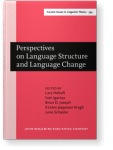Anticausative and passive in Vedic
Which way reanalysis?
In a 2001 publication on reanalysis and linguistic change, Henning Andersen states that “(i)t is not clear yet what constitutes structural ambiguity in surface realizations; this remains a question for the future”. As a tribute to Henning, this paper examines a case of (near-)systematic structural ambiguity regarding Vedic passives and anticausatives and demonstrates that this ambiguity creates serious obstacles to determining whether anticausatives are reanalyzed from passives or vice versa. In fact, given the persistent structural ambiguity it is possible that different speakers preferred different accounts, whether for all relevant verbs, for subsets of the verbs, or even for individual verbs, in individual contexts.
Article outline
- 1.Introduction
- 2.Structural characteristics of passive vs. anticausative in Vedic
- 3.Historical relationship between passives and anticausatives
- 3.1Early accounts
- 3.2Kulikov’s accounts and a possible alternative
- 3.3Another alternative account
- 3.4A further possibility
- 3.5Evaluation and conclusions
-
Notes
-
References
